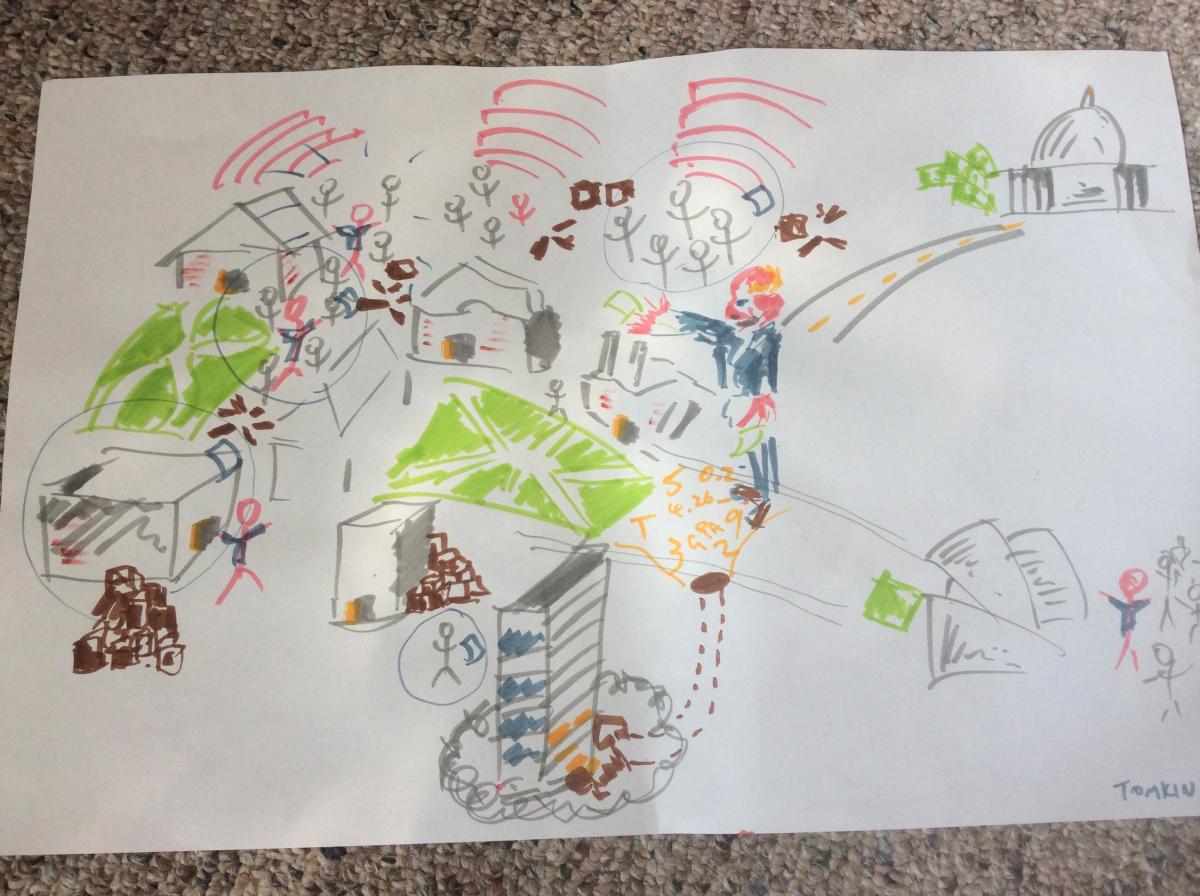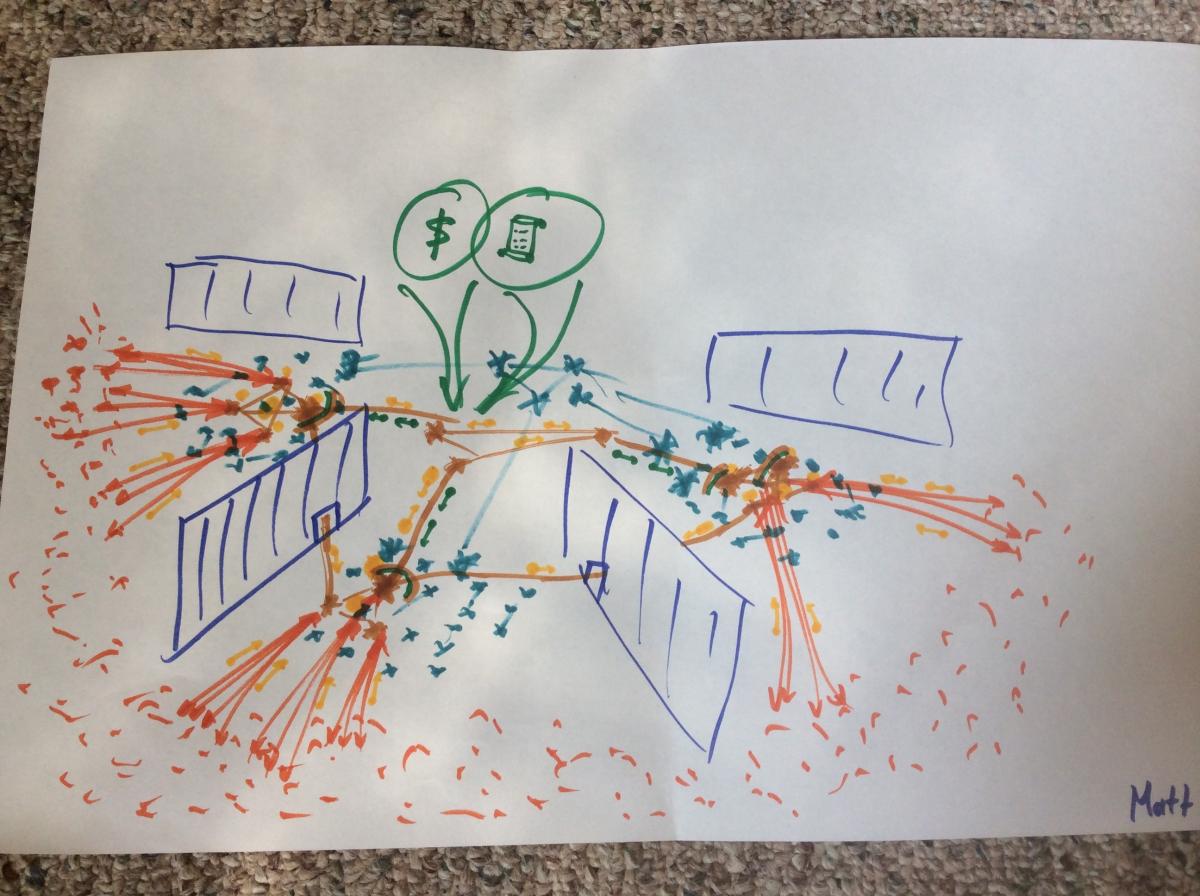Think back to the last time you drew a picture. Maybe it was last week when you found yourself doodling in a meeting. Or, perhaps it was much further back, when you were just a child.
Drawing pictures is a way to surface, represent, and explore what we are thinking and feeling. While we may associate drawing with childhood, many adults think visually and can learn and communicate better through drawings. Drawing rich pictures is a powerful way for individuals and groups to explore what they know and experience in a problem-situation or social change initiative as well as challenge assumptions and discover the unexpected. Rich pictures can complement system mapping techniques by providing an initial way for a group to discuss and develop shared understanding of what the “system” is that they want to map. Rich pictures are part of a systems approach developed by Peter Checkland called Soft Systems Methodology.
What is a rich picture?
“Rich pictures are compilations of drawings, pictures, symbols, and text that represent a particular situation or issue from the viewpoint(s) of the person or people who drew them. Rich pictures can show relationships, connections, influences, and cause and effect. They can also show more subjective elements such as character and characteristics as well as points of view, prejudices, spirit, and human nature. Rich pictures can both record and evoke insight into a situation. They can be regarded as pictorial ‘summaries’ of the physical, conceptual, and emotional aspects of the situation at a given time.” – Open University
Rich pictures are particularly useful for:
- Exploring and identifying which aspects and perspectives are important to include when mapping a system using other systems mapping techniques
- Capturing the structure and process of what is happening in a situation or initiative along with peoples’ subjective meanings, feelings, and values
- Communicating with others about a situation or initiative, particularly when there are cultural or language differences
- Developing a shared understanding of a situation or initiative as a group and motivating further dialogue, learning, and/or action
Using rich pictures in evaluation
In an evaluation of an initiative to reform introductory courses in Science, Technology, Engineering, and Mathematics (STEM) at a university, leaders and faculty members had different perspectives on the initiative. Their perspectives were influenced by their various roles (e.g., leader, researcher, instructor), disciplinary training (e.g., Physics, Computer Science, Education), cultural and linguistic backgrounds, and personal values and motivations for the initiative.
Our evaluation team used rich pictures to explore these multiple perspectives on the initiative and generate learning and conversation about the initiative and its context. We invited leaders and faculty members to a 1-hour session. We provided large sheets of paper, colorful markers, and simple instructions to each draw how he/she viewed and experienced the initiative and its context attempting to capture its full story. After 20 minutes of drawing, individuals shared what his/her drawing meant and, together, the group discussed similarities and differences between their perspectives and what these might mean for the initiative.
Check out 2 of the rich pictures:


Highlights from using rich pictures in this evaluation:
- Leaders and faculty members involved enjoyed drawing rich pictures, found the technique very accessible, and were surprised to discover both similarities and differences in how their colleagues viewed and experienced the initiative.
- Rich pictures were particularly valuable for surfacing and generating discussion about difficult issues including differences in power, status, and resources between some departments and multiple views on why the initiative was less successful in some departments.
Further resources on rich pictures:
- “The Art of Rich Pictures” video series
- Rich pictures tutorial
- If a Picture Paints a Thousand Words: The Use of Rich Pictures in Evaluation by Judy Oakden
Emily Gates is an evaluator and doctoral candidate at the University of Illinois at Urbana-Champaign. Her dissertation research examines the value and challenges of using systems thinking and systems approaches in evaluation practice.
Learn more about different system mapping techniques in the System Thinking Toolkit>
